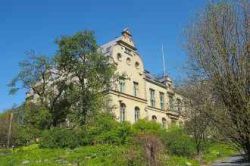
Botanical Museum (H), erected in 1902–1903, located in the heart of Helsinki… Photo: Laura Hiisivuori/Luomus
Botanical Museum, Finnish Museum of Natural History - University of Helsinki

P.O. Box 7
FI-00014 University of Helsinki
Helsinki
Finland
Web: http://www.luomus.fi/en
Prof. Soili Stenroos (Mycology & Bryology)
Email: soili.stenroos@helsinki.fi
Dr. Henry Väre (Vascular Plants)
Email: henry.vare@helsinki.fi
Collections of the Botanical Museum (H), founded in 1751, were all but destroyed in the great fire of Turku in September 1827, which prompted the Imperial degree to relocate the University to Helsinki. Originally chartered by Queen Christina of Sweden in 1640 as the Royal Academy of Turku, the University was renamed as the Imperial Alexander University of Finland, and has been known as the University of Helsinki since 1919.
Today the Botanical Museum (H) houses 3,3 million registered specimens of plants and fungi including 1,800,000 vascular plants, 630,000 bryophytes, 421,000 lichenized fungi, 423,000 non-lichenized fungi, and 22,000 algae. Estimated amount of types is 65,000 comprising 20,000 vascular plants, 25,000 bryophytes, 12,000 lichenized fungi, 7,000 non-lichenized fungi, and 500 algae.
The present two separate vascular plant herbaria, Herbarium fennoscandicum and Herbarium generale, roughly equal in size, are based on those ca. 5,000 specimens (Herb. C. R. Sahlberg) which escaped the havoc caused by the fire in Turku. The invaluable Herbarium Christian von Steven (23,000 species; received in 1860), incorporated into Herbarium generale, is heavily focused on materials from southern Russia, Ukraine including the Crimea, and the Caucasus, but also contains an abundance of specimens representing the four corners of the earth acquired through exchange with the botanical luminaries of the 1800's.
H is famous for its historical lichen and bryophyte collections, which are particularly rich in types. The most valuable lichen collections are those of E. Acharius (H-ACH; 5,500 specimens) and W. Nylander (H-NYL; 52,000 specimens). The collection of P. A. Karsten, including more than 2,000 types of non-lichenized fungi, is incorporated into the general collection of fungi. The bryophyte collections of V. F. Brotherus (H-BR; 120,000 specimens) and S. O. Lindberg (H-SOL; 48,000 specimens) are among the most significant in the world.
